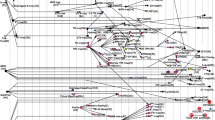Abstract
Despite pressing need, current relational database management systems (RDBMS) support for spatio-temporal data is limited and inadequate, and most existing spatio-temporal indices cannot be readily integrated into existing RDBMSs. This paper proposes a practical index for spatio-temporal (PIST) data, an indexing technique, rather than a new indexing structure, for historical spatio-temporal data points that can be fully integrated within existing RDBMSs. PIST separates the spatial and temporal components of the data. For the spatial component, we develop a formal cost model and a partitioning strategy that leads to an optimal space partitioning for uniformly distributed data and an efficient heuristic partitioning for arbitrary data distributions. For the temporal component of the data a B + -tree is used. We show that this layer’s performance can be maximized if an optimal maximal temporal range is enforced, and we present a procedure to determine such an optimal value. Being fully mapped onto a RDBMS, desirable and important properties, such as concurrency control, are immediately inherited by PIST. Using ORACLE as our implementation platform we perform extensive experiments with both real and synthetic datasets comparing its performance against other RDBMS-based options, as well as the MV3R-tree. PIST outperforms the former by at least one order of magnitude, and is competitive or better with respect to the latter, with the unarguable advantage that it can readily used on top of virtually any existing RDBMS.









Similar content being viewed by others
Notes
Details of which cannot be disclosed due to confidentiality reasons.
While some RBDMS do offer R-trees as a native index those are not nearly as widely available as B + -trees.
References
M. Abdelguerfi et al. “The 2-3TR-tree, a trajectory-oriented index structure for fully evolving valid-time spatio-temporal datasets,” in Proc. of ACM GIS, pp. 29–34, 2002.
M.J. Carey et al. “Shoring up persistent applications,” in Proc. of the ACM SIGMOD Conf., pp. 383–394, 1994.
V.P. Chakka et al. “Indexing large trajectory data sets with SETI ,” in Online Proc. of CIDR, 2003. http://www-db.cs.wisc.edu/cidr/cidr2003/program/p15.pdf
A. Guttman. “R-trees: a dynamic index structure for spatial searching,” in Proc. of the ACM SIGMOD Conf., pp. 47–57, 1984.
C.S. Jensen et al. “The INFATI data,” Technical Report TR-79, TimeCenter, 2004. http://arxiv.org/abs/cs.DB/0410001.
C.S. Jensen, D. Lin, and B.-C. Ooi. “Query and update efficient B + -Tree based indexing of moving objects,” in Proc. of VLDB, pp. 768–779, 2004.
R.V. Kothuri and S. Ravada. “Spatio-temporal indexing in oracle: issues and challenges,” IEEE TCDE Bulletin, Vol. 25(2):56–60, 2002.
H.-P. Kriegel, M. Pötke, and T. Seidl. “Managing intervals efficiently in object-relational databases,” in Proc. of VLDB, pp. 407–418, 2000.
P.M. Lewis, A.B., and M. Kifer. Database and transaction processing. Addison-Wesley, 2002.
D. Mallett. “Relational database support for spatio-temporal data,” Technical Report TR04-21 (M.Sc. Thesis), Dept. of Computing Science, Univ. of Alberta, 2004. http://www.cs.ualberta.ca/TechReports/2004/TR04-21/TR04-21.pdf.
M.F. Mokbel, T.M. Ghanem, and W.G. Aref. “Spatio-temporal access methods,” IEEE TCDE Bulletin, Vol. 26(2):40–49, 2003.
M.A. Nascimento and J.R.O. Silva. “Towards historical R-trees,” in Proc. ACM SAC, pp. 235–240, 1998.
D. Pfoser, C.S. Jensen, and Y. Theodoridis. “Novel approaches in query processing for moving object trajectories,” in Proc. of VLDB, pp. 395–406, 2000.
S.M. Ross. Introductory statistics. McGraw-Hill, 1996.
S. Saltenis et al. “Indexing the positions of continuously moving objects,” in Proc. of the ACM SIGMOD Conf., pp. 331–342, 2000.
H. Samet. “The quadtree and related hierarchical data structures,” ACM Comput. Surveys, Vol. 16(2):187–260, 1984.
Y. Tao and D. Papadias. “MV3R-Tree: a spatio-temporal access method for timestamp and interval queries,” in Proc. of VLDB, pp. 431–440, 2001.
Y. Tao, D. Papadias, and J. Sun. “The TPR*-Tree: an optimized spatio-temporal access method for predictive queries,” in Proc. of VLDB, pp. 790–801, 2003.
Y. Theodoridis and T. Sellis. “A model for the prediction of R-tree rerformance,” in Proc. of PODS, pp. 161–171, 1996.
Y. Theodoridis, J. R. O. Silva, and M. A. Nascimento. “On the generation of spatiotemporal datasets,” in Proc. of SSD, pp. 147–164, 1999.
Y. Theodoridis, M. Vazirgiannis, and T.K. Sellis. “Spatio-temporal indexing for large multimedia applications,” in Proc. of IEEE ICMCS, pp. 441–448, 1996.
Author information
Authors and Affiliations
Corresponding author
Rights and permissions
About this article
Cite this article
Botea, V., Mallett, D., Nascimento, M.A. et al. PIST: An Efficient and Practical Indexing Technique for Historical Spatio-Temporal Point Data. Geoinformatica 12, 143–168 (2008). https://doi.org/10.1007/s10707-007-0030-3
Received:
Revised:
Accepted:
Published:
Issue Date:
DOI: https://doi.org/10.1007/s10707-007-0030-3




